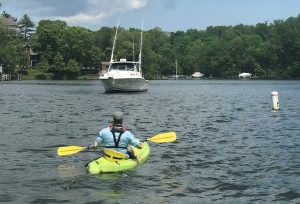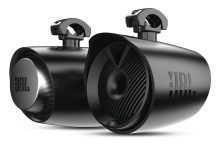On The Water, Separation Isn’t Just About Safe Distancing
With more paddlers and boaters sharing the water this summer,BoatUS Foundation offers etiquette tips to help ensure safety and fun for all

There are more recreational boats and paddlers hitting the water, all trying to have fun in a safe way. So what are these two groups doing this season to safely share more crowded waters?
“Ultimately, it’s about looking out for each other,” says BoatUS Foundation Assistant Director of Boating Safety Ted Sensenbrenner. The nonprofit boating safety and clean water arm of BoatUS shares some etiquette tips to make for a positive day on the water for paddlers and boaters alike.
Etiquette For Paddlers
- Be seen – but that may be harder than you think. Perhaps your kayak, life jacket or clothing is a neutral or dark color. As the day progresses, glare increases, waves kick up, and it becomes more difficult for recreational boaters to see you at a safe distance. Bright clothing and life jackets, warning flags, painting paddle blades bright colors and adding reflective tape to the tips can ultimately give boaters more time to steer clear of you.
- Try to cross channels at a 90-degree angle, and if you are with a group, cross together and not stretched out in a long line. This reduces the time you spend in a potentially hazardous waterway in which recreational vessels may be limited in navigation by size, draft or maneuverability.
- Even if you think you have right of way, practice defensive paddling to prevent collisions and mishaps in spite of the actions of others around you. Try to avoid heavy boat traffic, and pick a route away from congestion. Typically, it is safest to pass astern of other vessels and let them cross in front of you. Some boats have awkward blind spots that prevent good visibility at certain trim angles, so never assume a boater can see you.
Etiquette For Boaters
- Put down the phone, minimize distractions and be on the active lookout for small craft. The U.S. Coast Guard reports that operator inattention and improper lookout are at the top of the list for contributing factors to accidents. Consider learning the S.C.A.N. (Search, Concentrate, Analyze, and Negotiate) method to help you safely navigate around paddlers and other traffic on the water.
- While you may not be in an official slow speed zone, show courtesy and slow down in areas where paddlers congregate. Be mindful of your wake. One way for boat operators to check their courtesy is to ask themselves, “If my son or daughter were in the kayak I am about to pass, what would I do?”
- Paddling is booming, and paddlecraft rentals are here to stay. Accept and understand that some paddlers may not understand the rules of the road or all of the safety risks inherent to small-craft operation. Paddlecraft are highly maneuverable, so it’s good to give a little more breathing room on the water when you can. Everyone has a responsibility to avoid a collision.































